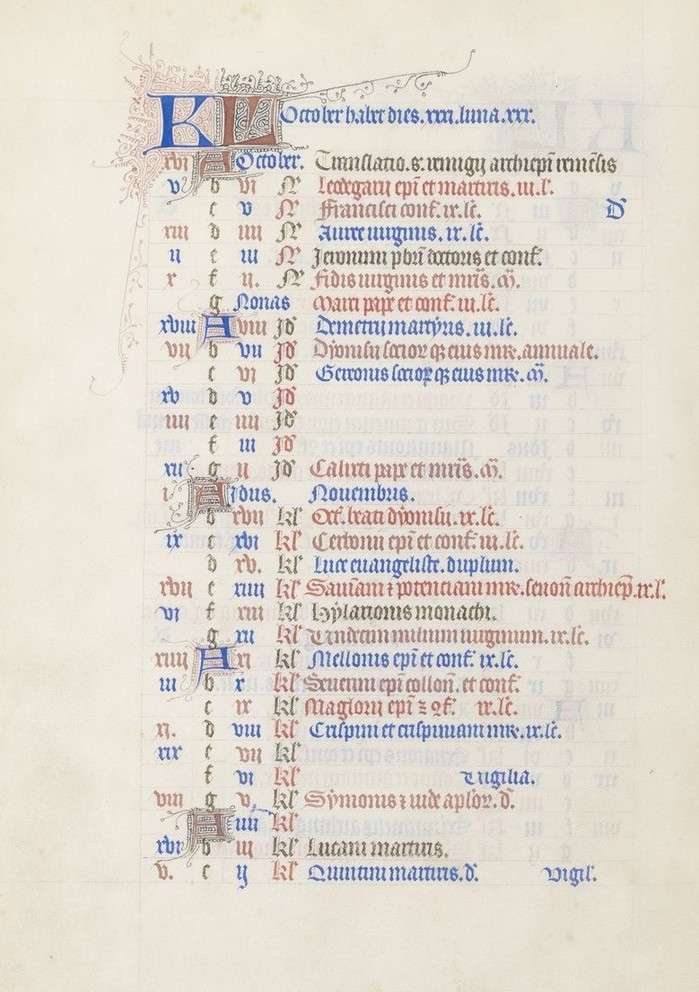Two more manuscripts from the Biblioteca Nacional de Espana, both Parisian, have been added in recent days.
Vitr/24/1 was in the collection of King Charles VIII (see 259), and dates to the very end of the 15th century. It has beautiful calendar, complete in French and graded gold, red/blue. Surrounding the labor of the month, on the outer margin, there are short French poems about the month. The entries are quite a mess, however. 43 appear to be on the wrong date with an additional 27 entries unidentified.
(DB Id: 287)
Vitr/24/7 is an earlier book, dating from circa 1400 with an unknown patron. It is named for a 19th century owner, the Duke of Osuna. The calendar is complete, with an unusual grading system, gold and red/black. Like the other Parisian Hours, this one has a calendar filled with errors. 52 entries are on the wrong date with an additional 65 unidentified.
(DB Id: 280)
A slew of Spanish Hours are coming in the near future, thanks to the detailed catalogue information in Josefina Planas’. Horae: el poder de la imagen : libros de hores en bibliotecas españolas. (Madrid: Orbis Mediaevalis, 2016). These are mostly not actually Spanish-made manuscripts, sadly, but a broad spectrum of French, Flemish, and Italian MS that are presently held in Spanish collections.
The first of these to be added is from the Biblioteca Nacional de Espagna, Vitr 23 10. This 13th C Parisian book is known as the Clinton Book of Hours, from the 15th C british owners. This manuscript starts with a long pictoral sequence, depicting two scenes of St. Edward the Confessor and then the life/death/resurrection of Jesus, leading to the calendar starting on f.29v.
The calendar itself is not graded, it uses gold and blue ink without obvious pattern. There is a tendency for lone important feasts to be gold, but when entries cluster they fall to simple alternation. Outside the main entries there are some of the Zodiac signs, 5 months, and many of the other informational notes (dates for easter and Rogation Keys). There are also several obituaries for members of the Clinton family in a later hand, in brown ink. The main entries are rather sparse, 142 dates populated, and most are the basic Parisian saints. With the exception of a row shift at the beginning of October(see f.37v below), the entries are accurate with only one incorrect entry elsewhere.
(DB Id: 279)
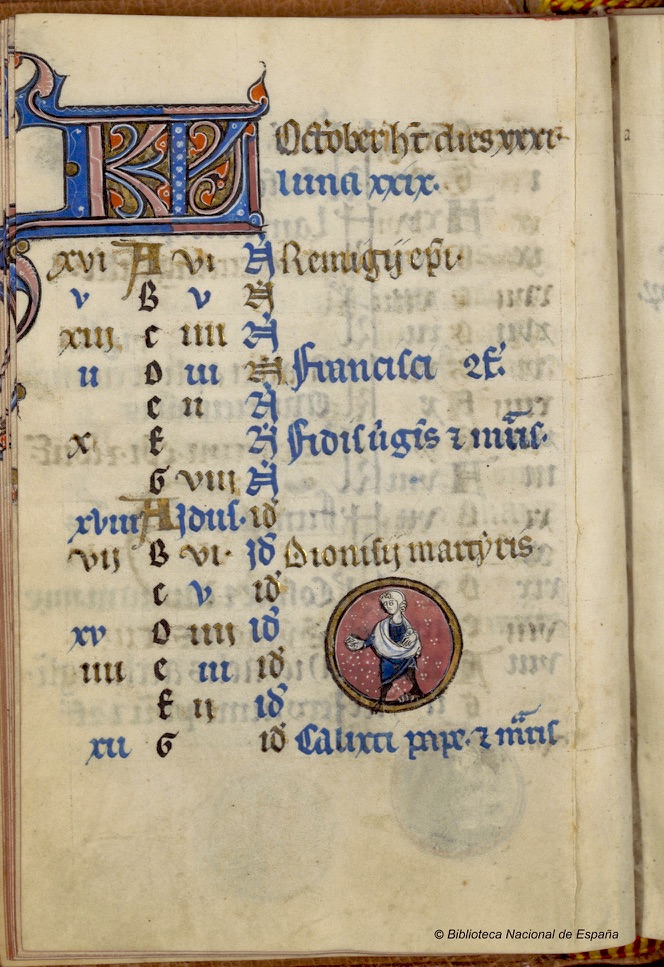
From the Bibliothèque nationale de France comes Latin 1173, the Hours of Charles d’Angoulême, made in France in the Late 15th C. Charles was the father of King François I(r. 1515-1547), and is identified by his arms on f.53r. The Hours are Use of Paris, but the calendar has not been localized.
Most of the literature on this MS is not focused on the text at all, but either the miniatures. Many of these are originals by Robinet Testard, but several are actually prints by Israel van Meckenem (signed IM), which have been colored and embellished by Testard. The calendar is populated with quite distinct illustrations. The labors of the month are unusual and 9 of the KL initials are formed by humans, often in brown/blue clothing, contorted and posing with strange beasts. May (f.3r below) is a representative example, with the woman seemingly unconcerned by the dragon attacking her to form the arms of the “K”. What seems to be the labor is, in fact, two “wild men” jousting
In the content of the calendar there are both some unusual saints listed as well as an interesting bit of scribal error. The calendar starts out mostly full, 27 in Jan, but immediately starts to open up, with only 12 in February. In January some of the entries are quite rare, eg. the heretofore unique 40 Martyrs (4294) on Jan 9.
The calendar starts out triple-graded, blue/red/black, and is carefully graded, several multiple-saint entries are graded distinctly for each saint. In November, however, the scribe seems to forget that he’s triple-grading, and starts to use red and blue in simple alternation when there are high-ranks. This was less definitive in early November, All Saints (2850) in blue vs. All Souls (2993) in red, but becomes more evident as the month proceeds. In December it is unavoidable with strict alternation of red/blue in the Christmas (814) through Holy Innocents (823) block. Were this still triple graded, Christmas, in red, would be outranked by the Holy Innocents and even St. Barbara (853), both in blue.
(DB Id: 278)
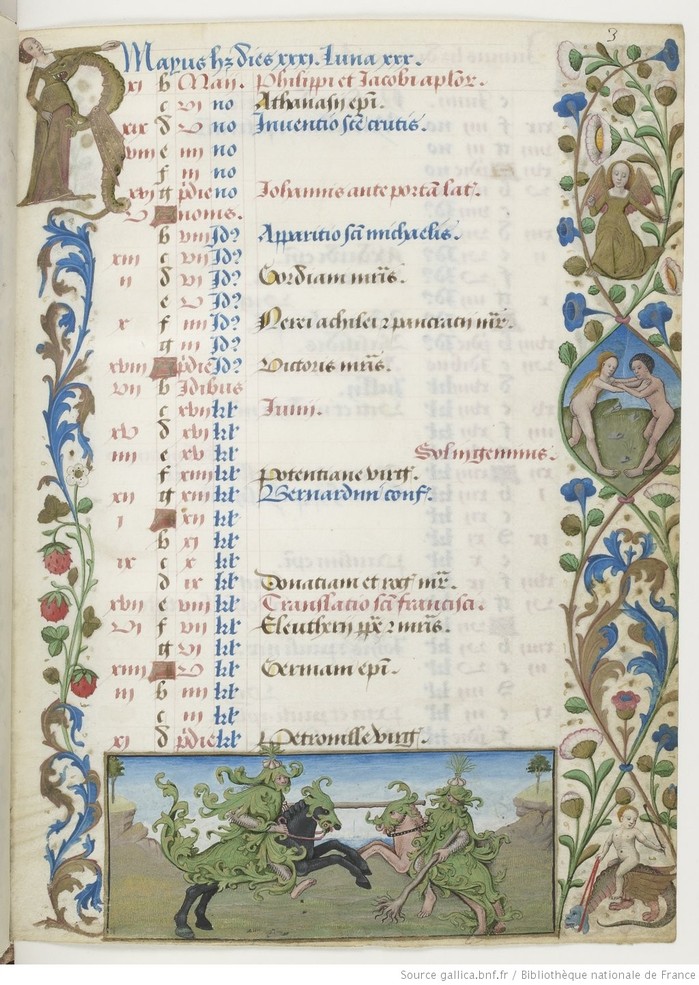
Another library joins the database with the addition of Ms.1185 from the Bibliothequè de l’Arsenal, located in Paris near the former site of the Bastille. This is a 15th C. Book from Cambrai, now in northern France. The book is in a very high quality bâtarde hand, with multiple flourished (nearly cadel) capitals in the calendar test. There are also illusionistic borders, with shell-gold backgrounds, on the outer edge of every page, both text and calendar, except for those with more complex decorative programs.
The text of the calendar is in French with some very specific-to-Cambrai entries, such as Bishop Gaugericus (feast in red on August 11 (370), Octave on August 18 (4007), elevation on September 24 (3803)).
An interesting variant is the indication of the Epiphany (January 6 (1488)) (see f.1r below). In French calendars this is usually spelled as La Tiphaine (or a varient thereof), however in MS.1185 it is spelled in hybrid La epyphanie n[ost]re s[iegneu]r. The article is never seen in Latin calendars, but neither Epyphanie nor vocal variants, are seen in French Calendars. The closest match to this entry, oddly, is the early 16th C. Ventian calendar in Houghton MS Typ.1000
(DB Id: 265)
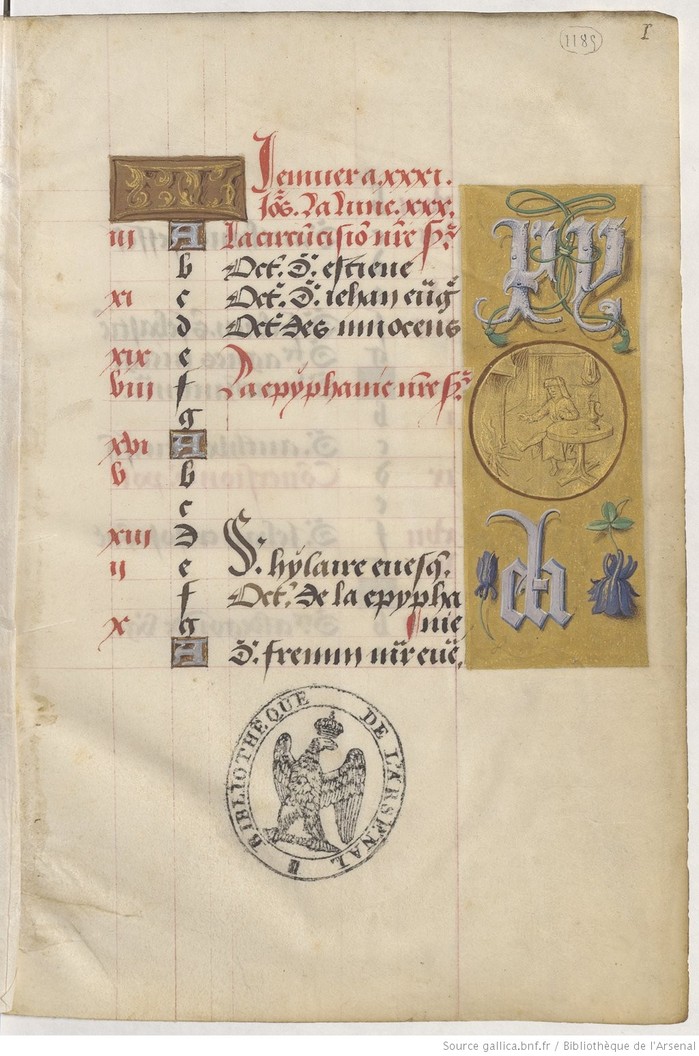
Utopia Cod.111 is one of the many Parisian Hours, but with an unusual pedigree. King Charles VIII was a voracious bibliophile, and so was often gifted manuscripts by those wishing to curry favor. One of these is Cod.111, given by the parisian bookseller Anthoine Vérard about 1488, is an exquisite manuscript and the eponymous work of it’s illuminator, the Master of Charles VIII. It it completely illuminated, with every page having, at minimum, a vegetal border with Old Testament scenes inset in the outer margin. Throughout are full page miniatures. Many are the usual Life of Mary sequence, but some are more inventive, such as an opening depicting the Genealogy of Christ, from Adam through the Jesse on 14v and Jesse through Mary to Christ on 15r.
The calendar is equally lavish in decoration, with 2-columns of feasts set within a architectural border populated with the sign of the zodiac, the labor of the month and various Saints. The scribal work was not well coordinated with the illumanation, with multiple instances of the capitol “s” in a column where the feast is not for a Saint. This lack of communication continues in the month names, each of which is missing the first letter.
The entries are in the common Parisian color scheme, red/blue for common and gold for high-importance feasts. The entries are almost all identifiable, but riddled with errors, usually coming in blocks. For example for the thirteen entries in November 7-19, ten are on the wrong date. Interestingly in that block, the Feast of St Martin of Tours 2872 is on the wrong date but the Octave 2971 is correct. It seems like this block was shifted around to permit two saints with the same date to be included, but in an overly complex scheme (see f.7r below)
(Db ID: 259)
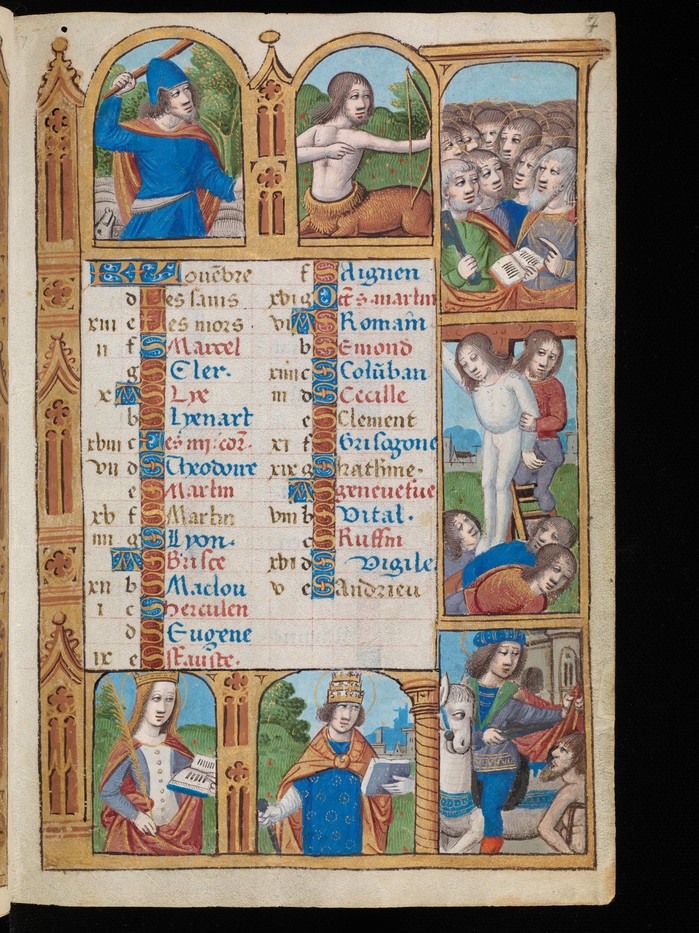
The Utopia, armarium codicum bibliophilorum collection (roughly translates to bookshelf of book-lovers) hosted at e-Codices is the location for privately-held manuscripts who’s owners allowed them to be digitized, but do not wish to be known. From that two books have been recently added, cod.109 and cod.111. Both of these are mid-15th century manuscripts from France, but after that they are distinctly different.
Cod.109 is from Angers, once the capitol of Anjou and about 300km from Paris, and dates from about 1430. It isn’t an unusually beautiful hours, but nicely executed with bright colors and wide borders filled with tiny leaves. The calendar is mostly full, with about 50 empty dates, though there is not a single feast with 2 different saints, not even the common pairing of St. James 1761 and St. Christopher 1757 on July, 25. The error rate is pretty low, only 18, but they seem to come in groups. Some unusual saints seem to reflect the uncommon use, such as St Gratian 3418 (in red) on October 23.
(Db ID: 260)
From a new source, the Archives of the Canton of Vaud, comes a nice Parisian Book of Hours, shelfmark P. Château de La Sarraz H 50. As a Swiss Cantonal library, this manuscript is comprehensively catalogued and digitized in e-Codices. Helpfully for localization and dating, this has a colophon* on f. 193v stating that it was made in the workshop of the Parisian bookseller Jacquet Lescuier in 1421 and bought, though possibly not comissioned, by Jean II de Gingins.
The calendar is not terribly unusual for a Parisian complete calendar, with just red and black entries. There are some errors, but no more than expected with a complete calendar. A couple of the entries are unclear due to the gothic biting.
(DB Id: 237)
* Ces heures sont a Jehan de gingins seigneur duione et capitaine surgens darmes pour le roy nostre sire. Et furent faites a larue neufue n[ost]re dame par iaquet lescuier. Lan .mil.CCCC.XXI.
A quick summary of several Books of Hours added from my most recent trip to the Morgan Library in New York.
- M.141 - A late 14th C Parisian book, with a simple red/black complete calendar. There are errors in the listings, but no more than the usual number. The later months have multiple unidentified saints, including a saint “Olati” for Dec. 10 and Saint “Dani” on Dec. 5. (DB Id: 234)
- M.729 - The Hours of Yolande de Soissons, this is a Psalter/Hours, but has been added due to the unusually specific location, Amiens, and the rather precise date, 1280-1299, for such an early book. The Calendar has some specific-to-Amiens feasts, such as the Octave of St. Firminus, October 2. It’s triple graded as well, with blue for high importance and red for more medium-weight saints, though that is not a definite interpretation. (DB Id: 77)
- M.739 - This is a particularly old hours, 1204-1219, and from Moravia, which is a rare location. The calendar is damaged for the month of January, with the last 10 entries very difficult to read. There is also evidence of multiple generations of writing and rewriting, including additional saints and obituaries. Five entries for November were erased and rewritten, and it is unknown if these were changed. Of the saints from the original strata there are many unusual ones, such as St. Columba, along with the usual Pope Silvester, on December 31. Multiple saints are not yet identified. (DB Id: 175)
- M.1054 - A nice late 15th C book of hours from Tours, decorated, according to the catalogue by a “Distant follower of Jean Bourdichon”. The calender has a fantastic architectural border on the rectos, with the zodiac and the labors integrated into the frame. Interestingly the calendar is unevenly split, with about 20-22 entries on the recto and only a few on the versos. It is almost complete, but several months have a missing name for the last of the month. (DB Id: 228)
- S.9 - A Parisian book, illustrated by two associates of the Luçon master. The calendar is error-filled, both containing many saints on the wrong date as well as having many of the initials incorrectly filled in as ‘S’, such as “Sostre Dame” for Nostre Dame and “Ses Innocens” for Les Innocens. (DB Id: 226)
Note that with these additions, the total number of entries in the DB is 48910, 31951 of those have at least one saint.
Houghton Library MS Typ 51 is a tiny (see below with iPhone) Book of Hours from France, dated to 1552. Though the title page and some running titles are in French, all of the prayers and the Calendar are in Latin. The calendar is mostly complete, 340 feasts and a few zodiac entries, but has enough blanks that it isn't clear it was ever intended to be full. The saints are a mish-mash, many are weeks or even months off of the proper date. Interestingly, unlike many of the complete Parisian calendars, some, but not nearly all, of the saints have titles (Bishop, virgin, etc). Some of the unusual errors are: Abdon et sennem (Abdon and Sennen) on March 30, their feast is July 30; Scolastice (St. Scholastica) on April 10 instead of February 10; Cleti pape (Pope Cletus) on November 5th, October 12 is his closest feast. Besides these large errors there are numerous saints shifted by 2-4 days, some be as much as a week or 10 days within the same month. There are also many unidentified saints who might be shifted from elsewhere in the calendar. In total I count 29 errors, or almost 10% of the total entries, not counting unidentified saints who might be erroneous.
(DB Id: 224)
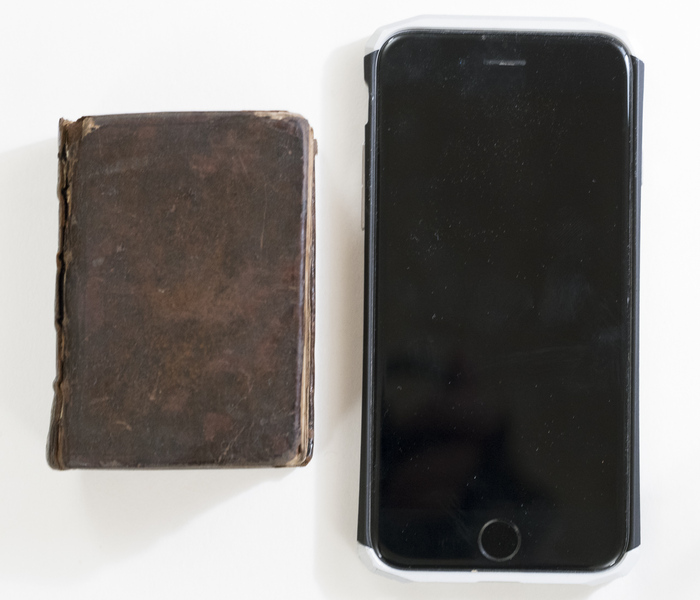
Bibliothèque nationale de France Nouvelle acquisition latine 3093 is one of the multiple fragments of a complex manuscript, which was owned and possibly comissioned by Jean, Duc de Berry (yes, that Duc de Berry). The BnF fragment, called the Très Belles Heures de Notre-Dame, is mostly Book of Hours content, but the manuscript originally contained a Psalter and some of a Missel as well. Even without touching on the complex history of creation and illumination, the calendar is interesting in it's own right. The entries are mostly standard for Paris, though there are a large number of local bishops specified with their See, (see Sts. Savian and Potencian, October 19, on f.Vv below. Their see of Sens is recorded). There are also some of the specifically Parisian royal feasts, including both the Crown of Thorns (Aug. 11) and Relics of St. Chapelle (Sept. 30) and multiple kings and queens.
The coloring seems to have no pattern at all, sadly. There are 4 colors used, red, blue, pink (distinct from the red, perhaps a faded purple) and black, which might be lost gold, and many of the feasts have size indications in the right margin (3 or 9 lessons, or Annuale), but there seems to be no correlation between color and rank. High-rank feasts are often blue, but in November, where the month is mostly full, it seems to be a simple pattern (blue is roughly every 3rd feast), and St. Andrew, an apostle, is pink.
(DB Id: 197)
